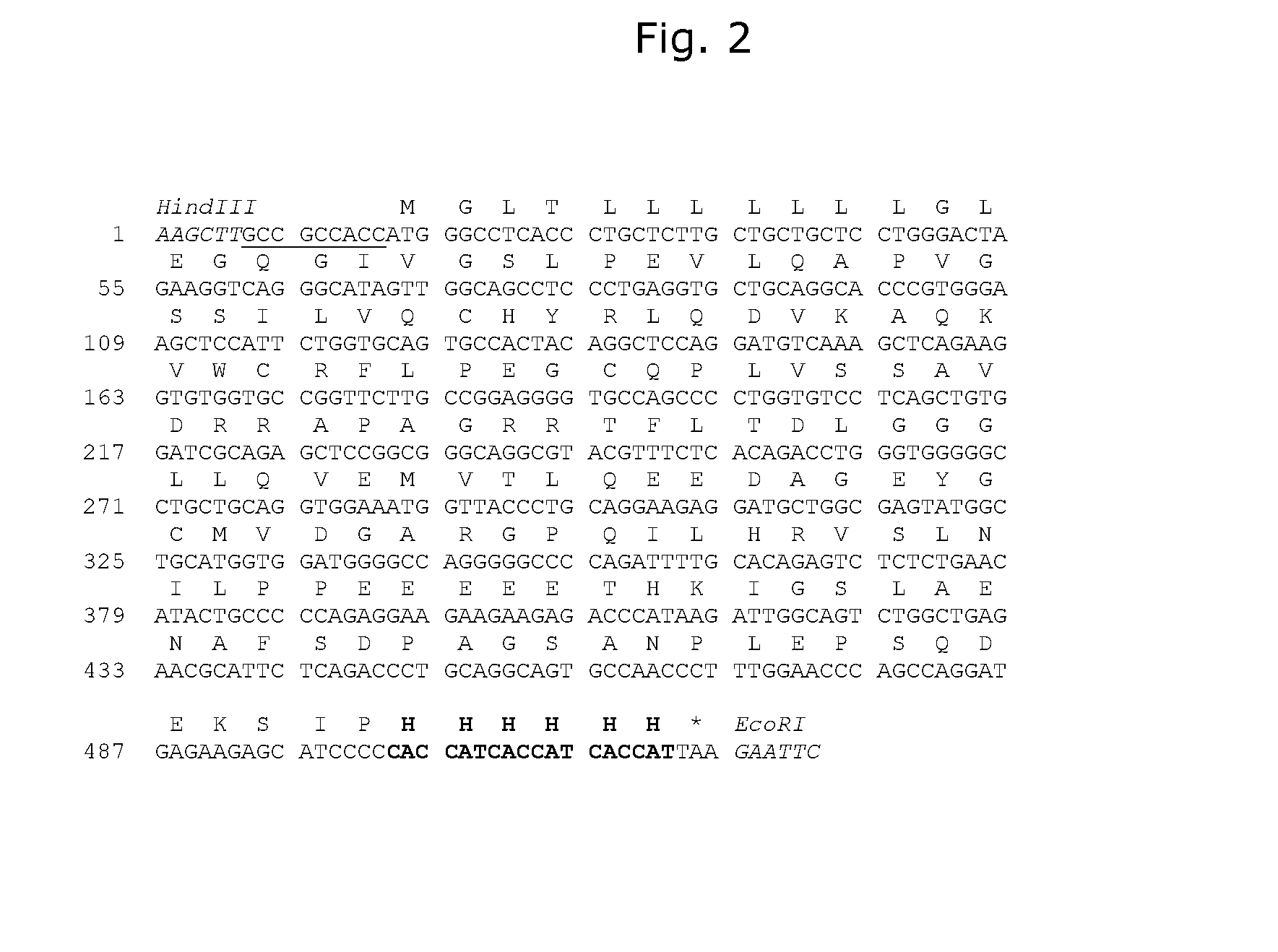Coagulation factor-targeting to tlt-1 on activated platelets
a coagulation factor and activated platelet technology, applied in the field of procoagulant proteins and polynucleotides, can solve the problems of threatening bleeding, spontaneous bleeds, and dysfunctional coagulation cascade steps
- Summary
- Abstract
- Description
- Claims
- Application Information
AI Technical Summary
Benefits of technology
Problems solved by technology
Method used
Image
Examples
example 1
Cloning and Expression of hTLT-1 ECD-his Antigen
[0570]Nucleotide sequences encoding the extracellular domain of human TLT-1 (hTLT-1) (FIG. 1) together with a C-terminal His-6 tag were PCR amplified with a forward primer containing a HindIII recognition site together with a kozak sequence, and a reverse primer containing a stop codon and an EcoRI recognition site (FIG. 2). The HindIII- and EcoRI digested PCR fragment was inserted into the HindIII- and EcoRI sites of a pTT-based expression vector. The pTT vector is essentially described in Durocher, Y. et al., (2002) Nucleic Acid Res, 30: E9. The resulting expression plasmid was designated pTT-hTLT-1 ECD-His. The nucleotide and amino acid sequences for hTLT-1 ECD-His is shown in SEQ ID NO: 3 and 4. pTT-hTLT-1 ECD-His was transfected into HEK293-6E suspension cells in order to transiently express hTLT-1 ECD-His. HEK293-6E cells were grown in Freestyle HEK293 medium (GIBCO, cat. no. 12338-018) supplemented with 1% P / S (GIBCO cat. no. 15...
example 2
Purification and Characterisation of hTLT-1 ECD-his Protein
[0571]Purification of the hTLT-1 ECD-His protein was conducted as a 2-step process composed of 1) His-affinity chromatography using the Cobalt-loaded resin TALON (Clontech, cat. no. 635506) and 2) anion-exchange chromatography using the fine-particle resin Source 15Q (GE Healthcare, cat. no. 17-0947). The purifications were conducted using an ÄktaExplorer chromatography system (GE Healthcare, cat. no. 18-1112-41). The buffer systems used for the first purification step was an equilibration buffer composed of 20 mM Hepes, pH 7.0, 150 mM NaCl, a wash buffer composed of 20 mM Hepes, pH 7.0, 0.5 M NaCl and an elution buffer composed of 20 mM Hepes, pH 7.0, 150 mM Imidazole. The cell supernatant was applied directly without any adjustments onto a pre-equilibrated TALON column. The column was washed with 20 column volumes of equilibration buffer, 20 column volumes of wash buffer and last with 20 column volumes of equilibration buf...
example 3
Preparation of Monoclonal TLT-1 Antibodies
[0573]RBF mice were immunized by injecting 50 μg of hTLT-1 ECD-His. FCA subcutaneously followed by two injections with 20 μg of hTLT-1 ECD-His in FIA. High responder mice were boosted intravenously with 25 μg of hTLT-1 ECD-His and the spleens were harvested after 3 days. Spleen cells were fused with the myeloma Fox cell line. Supernatants were screened for hTLT-1 specific antibody production in a specific ELISA and in a FACS assay utilizing hTLT-1- or Mock-transfected CHO cells as positive and negative target cells, respectively. A secondary screen was done on resting versus dual agonistic activated platelets of human, cynomolgous monkey, dog, rabbit or mouse origin.
PUM
| Property | Measurement | Unit |
|---|---|---|
| Coagulation enthalpy | aaaaa | aaaaa |
Abstract
Description
Claims
Application Information
 Login to View More
Login to View More - R&D
- Intellectual Property
- Life Sciences
- Materials
- Tech Scout
- Unparalleled Data Quality
- Higher Quality Content
- 60% Fewer Hallucinations
Browse by: Latest US Patents, China's latest patents, Technical Efficacy Thesaurus, Application Domain, Technology Topic, Popular Technical Reports.
© 2025 PatSnap. All rights reserved.Legal|Privacy policy|Modern Slavery Act Transparency Statement|Sitemap|About US| Contact US: help@patsnap.com



